What engineering feat was this pharaohs gift to the people of Egypt
| Summit: Great Pyramid of Giza (c. 2589-2566 BC); Middle: Columns of the Slap-up Hypostyle Hall from the Temple of Karnak (c. 1294-1213 BC); Bottom: Temple of Isis from Philae (c. 380 BC-117 AD) | |
| Years active | c. 3100 BC-300 AD |
|---|---|
Spanning over ii thousand years, ancient Egypt was non one stable civilization but in constant change and upheaval, unremarkably divide into periods past historians. Too, ancient Egyptian architecture is non one fashion, but a set of styles differing over fourth dimension only with some commonalities.
The best known example of ancient Egyptian architecture are the Egyptian pyramids while excavated temples, palaces, tombs and fortresses have also been studied. Most buildings were built of locally available mud brick and limestone by levied workers. Awe-inspiring buildings were built via the post and lintel method of structure. Many buildings were aligned astronomically. Columns were typically adorned with capitals busy to resemble plants important to Egyptian civilization, such every bit the papyrus institute.
Ancient Egyptian architectural motifs have influenced compages elsewhere, reaching the wider world first during the Orientalizing period and again during the nineteenth-century Egyptomania.
Characteristics [edit]
-
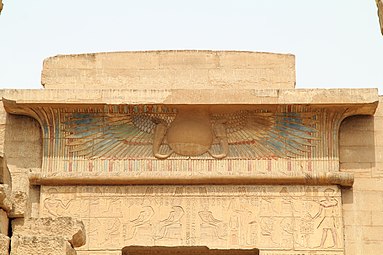
Winged sunday on a cavetto from the Medinet Habu temple complex. The winged sun represents a form of the falcon god Horus, son of Isis, triumphant over his enemies. The image was likewise a common protective device over temple entrances
Due to the scarcity of forest,[1] the 2 predominant building materials used in ancient Egypt were sun-baked mud brick and stone, mainly limestone, but likewise sandstone and granite in considerable quantities.[2] From the Erstwhile Kingdom onward, stone was mostly reserved for tombs and temples, while bricks were used even for imperial palaces, fortresses, the walls of temple precincts and towns, and for subsidiary buildings in temple complexes. The core of the pyramids consisted of locally quarried stone, mud bricks, sand or gravel. For the casing, stones were used that had to exist transported from farther away, predominantly white limestone from Tura and scarlet granite from upper Egypt.
Aboriginal Egyptian houses were made out of mud collected from the damp banks of the Nile river. It was placed in moulds and left to dry out in the hot sunday to harden for use in construction. If the bricks were intended to be used in a royal tomb like a pyramid, the outside bricks would as well be finely chiselled and polished.
Many Egyptian towns have disappeared because they were situated near the cultivated area of the Nile Valley and were flooded as the river bed slowly rose during the millennia, or the mud bricks and lord's day-dried brick of which they were built were used by peasants as fertilizer. Others are inaccessible, new buildings having been erected on ancient ones. However, the dry, hot climate of Egypt preserved some mud brick structures. Examples include the village Deir al-Madinah, the Middle Kingdom town at Kahun,[3] and the fortresses at Buhen[4] and Mirgissa. Also, many temples and tombs accept survived considering they were congenital on high ground unaffected by the Nile alluvion and were constructed of stone.
Thus, our agreement of ancient Egyptian compages is based mainly on religious monuments,[five] massive structures characterized by thick, sloping walls with few openings, perhaps echoing a method of construction used to obtain stability in mud walls. In a similar fashion, the incised and flatly modeled surface adornment of the stone buildings may have derived from mud wall ornamentation. Although the employ of the arch was developed during the 4th dynasty, all monumental buildings are mail service and lintel constructions, with flat roofs constructed of huge rock blocks supported by the external walls and the closely spaced columns.
Exterior and interior walls, besides as the columns and piers, were covered with hieroglyphic and pictorial frescoes and carvings painted in bright colors.[six] Many motifs of Egyptian decoration are symbolic, such as the scarab, or sacred protrude, the solar disk, and the vulture. Other common motifs include palm leaves, the papyrus found, and the buds and flowers of the lotus.[7] Hieroglyphs were inscribed for decorative purposes as well as to record historic events or spells. In addition, these pictorial frescoes and carvings permit us to sympathise how the Aboriginal Egyptians lived, statuses, wars that were fought, and their beliefs. This was specially true in recent years when exploring the tombs of Ancient Egyptian officials.
Ancient Egyptian temples were aligned with astronomically pregnant events, such every bit solstices and equinoxes, requiring precise measurements at the moment of the particular outcome. Measurements at the most significant temples may have been ceremonially undertaken past the Pharaoh himself.[8]
Columns [edit]
-
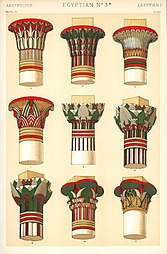
Illustration of other nine types of capitals, from The Grammar of Ornament
Every bit early on equally 2600 BC the architect Imhotep made use of stone columns whose surface was carved to reflect the organic course of arranged reeds, like papyrus, lotus and palm; in later Egyptian compages faceted cylinders were also common. Their class is thought to derive from primitive reed-built shrines. Carved from rock, the columns were highly decorated with carved and painted hieroglyphs, texts, ritual imagery and natural motifs. Egyptian columns are famously present in the Bang-up Hypostyle Hall of Karnak (circa 1224 BC), where 134 columns are lined up in xvi rows, with some columns reaching heights of 24 metres.
One of the well-nigh important type are the papyriform columns. The origin of these columns goes back to the 5th Dynasty. They are composed of lotus (papyrus) stems which are drawn together into a package decorated with bands: the uppercase, instead of opening out into the shape of a bellflower, swells out and and so narrows again like a bloom in bud. The base of operations, which tapers to take the shape of a half-sphere similar the stalk of the lotus, has a continuously recurring decoration of stipules. At the Luxor Temple, the columns are reminiscent of papyrus bundles, peradventure symbolic of the marsh from which the ancient Egyptians believed the creation of the earth to have unfolded.
Giza pyramid complex [edit]
The Giza Necropolis stands on the Giza Plateau, on the outskirts of Cairo, Arab republic of egypt. This complex of ancient monuments is located some 8 kilometers (5 mi) inland into the desert from the sometime town of Giza on the Nile, some 20 kilometers (12 mi) southwest of Cairo city center. This ancient Egyptian necropolis consists of the Pyramid of Khufu (also known as the Slap-up Pyramid or the Pyramid of Cheops), the somewhat smaller Pyramid of Khafre (or Kephren/Chefren), and the relatively modest-sized Pyramid of Menkaure (or Mykerinus/Mycerinus), along with a number of smaller satellite edifices, known as "queens" pyramids, the Great Sphinx likewise as a few hundred mastabas and chapels.[ix]
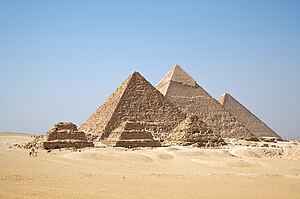
The three main pyramids at Giza, together with subsidiary pyramids and the remains of other structures at the Giza pyramid complex
The pyramids, which were built in the Fourth Dynasty, testify to the power of the pharaonic religion and state. They were built to serve both as grave sites and also every bit a manner to make their names final forever.[10] The size and simple design prove the loftier skill level of Egyptian pattern and engineering on a large scale.[x] The Great Pyramid of Giza, which was probably completed c. 2580 BC, is the oldest of the Giza pyramids and the largest pyramid in the world, and is the only surviving monument of the Seven Wonders of the Ancient World.[xi] The pyramid of Khafre is believed to have been completed effectually 2532 BC, at the finish of Khafre'south reign.[12] Khafre ambitiously placed his pyramid adjacent to his father'south. Information technology is not equally alpine as his father's pyramid just he was able to give it the impression of appearing taller by edifice it on a site with a foundation 33 feet (10 m) higher than his father's.[12] Along with building his pyramid, Chefren deputed the building of the giant Sphinx as guardian over his tomb. The face of a homo, possibly a delineation of the pharaoh, on a lion's body was seen equally a symbol of divinity among the Greeks fifteen hundred years afterwards.[ten] The Neat Sphinx is carved out of the limestone bedrock and stands about 65 anxiety (20 thousand) tall.[10] Menkaure's pyramid dates to circa 2490 BC and stands 213 feet (65 one thousand) high making it the smallest of the Great Pyramids.[xiii]
Popular culture leads people to believe that Pyramids are highly disruptive, with many tunnels within the pyramid to create defoliation for grave robbers. This is not true. The shafts of pyramids are quite simple, generally leading directly to the tomb. The immense size of the pyramids attracted robbers to the wealth that lay inside which acquired the tombs to exist robbed relatively soon subsequently the tomb was sealed in some cases.[ten] There are sometimes additional tunnels, but these were used for the builders to empathise how far they could dig the tomb into the crust of the Earth. Also, information technology is popularly thought that due to grave robbers, future kings were buried in the Valley of the Kings to help go on them hidden. This is also fake, as the pyramid construction connected for many dynasties, only on a smaller scale. Finally, the pyramid construction was stopped due to economic factors, not theft.
New Kingdom Temples [edit]
Luxor Temple [edit]

The Luxor Temple is a huge aboriginal Egyptian temple complex located on the due east bank of the River Nile in the urban center today known as Luxor (ancient Thebes). Construction work on the temple began during the reign of Amenhotep 3 in the 14th century BC. Horemheb and Tutankhamun added columns, statues, and friezes – and Akhenaten had before obliterated his father's cartouches and installed a shrine to the Aten – but the only major expansion endeavour took place nether Ramesses Two some 100 years after the first stones were put in place. Luxor is thus unique among the main Egyptian temple complexes in having only ii pharaohs leave their mark on its architectural structure.

The temple proper begins with the 24 yard (79 ft) loftier Kickoff Pylon, built by Ramesses II. The pylon was decorated with scenes of Ramesses's military triumphs (particularly the Battle of Qadesh); later pharaohs, particularly those of the Kushite dynasty, also recorded their victories there. This primary archway to the temple complex was originally flanked by six colossal statues of Ramesses – 4 seated, and two standing – merely only two (both seated) accept survived. Modernistic visitors tin can also see a 25 g (82 ft) tall pink granite obelisk: this one of a matching pair until 1835, when the other one was taken to Paris where it now stands in the centre of the Identify de la Concorde.
Through the pylon gateway leads into a peristyle courtyard, also built by Ramesses II. This area, and the pylon, were congenital at an oblique angle to the remainder of the temple, presumably to adjust the 3 pre-existing barque shrines located in the northwest corner. After the peristyle courtyard comes the processional colonnade congenital by Amenhotep III – a 100 g (330 ft) corridor lined by 14 papyrus-capital columns. Friezes on the wall describe the stages in the Opet Festival, from sacrifices at Karnak at the top left, through Amun'due south arrival at Luxor at the end of that wall, and last with his render on the opposite side. The decorations were put in place by Tutankhamun: the boy pharaoh is depicted, but his names have been replaced with those of Horemheb.
Beyond the colonnade is a peristyle courtyard, which also dates back to Amenhotep's original construction. The all-time preserved columns are on the eastern side, where some traces of original color can be seen. The southern side of this courtyard is fabricated up of a 36-column hypostyle court (i.east., a roofed space supported past columns) that leads into the dark inner rooms of the temple.
Temple of Karnak [edit]
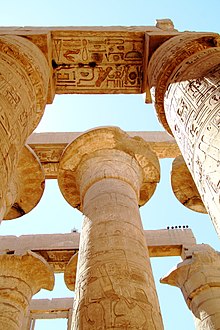
Example of inscriptions nowadays throughout the complex. The upper regions are painted, suggesting (in canon with other such temples) that the remaining columns and ceilings would have been brightly painted. The temple roof, representing the heavens,[14] often bore images of stars and birds, while the columns frequently bore images of palms, lotuses, and people.
The temple circuitous of Karnak is located on the banks of the Nile River some 2.5 kilometers (1.5 mi) north of Luxor. It consists of four main parts, Precinct of Amon-Re, the Precinct of Montu, the Precinct of Mut and the Temple of Amenhotep IV (dismantled), also every bit a few smaller temples and sanctuaries located outside the enclosing walls of the four main parts, and several avenues of ram-headed sphinxes connecting the Precinct of Mut, the Precinct of Amon-Re and Luxor Temple. This temple complex is especially significant, for many rulers accept added to it. However, notably every ruler of the New Kingdom added to it. The site covers over 200 acres and consists of a serial of pylons, leading into courtyards, halls, chapels, obelisks, and smaller temples. The primal departure between Karnak and nigh of the other temples and sites in Arab republic of egypt is the length of fourth dimension over which it was adult and used. Construction work began in the 16th century BC, and was originally quite modest in size, merely somewhen, in the main precinct solitary, every bit many every bit twenty temples and chapels would be constructed.[xv] Approximately 30 pharaohs contributed to the buildings, enabling it to reach a size, complexity and variety non seen elsewhere. Few of the private features of Karnak are unique, but the size and number of those features are overwhelming.

Recreation of the temple circuitous, at Karnak visitor center
One of the greatest temples in Egyptian history is that of Amun-Ra at Karnak. Every bit with many other temples in Egypt, this one details the feats of the past (including thousands of years of history detailed via inscriptions on many of the walls and columns found on site, oftentimes modified or completely erased and redone by post-obit rulers), and honors the gods. The temple of Amun-Re was constructed in 3 sections, the third beingness constructed past the later New Kingdom pharaohs. In canon with the traditional style of Egyptian architecture, many of the architectural features, such every bit the inner sanctum of the complex, were aligned with the dusk of the summer solstice.
One of the architectural features present at the site is the 5,000 sq chiliad (l,000 sq ft) hypostyle hall built during the Ramesside period. The hall is supported by approximately 139 sandstone and mud brick columns, with 12 central columns (~69 anxiety alpine) that would have all been brightly painted.
Ramesseum [edit]

Ramesses' mortuary temple adheres to standard New Kingdom temple-architecture style. Oriented northwest to southeast, the temple entrance comprises a number of stone figures, one located horizontally to the next. At center of the complex was a covered 48-column hypostyle hall, surrounding the inner sanctuary.
Ramesses II, a 19th Dynasty pharaoh, ruled Egypt from around 1279 to 1213 BCE. Among his many accomplishments, such every bit the expansion of Egypt's borders, he constructed a massive temple called the Ramesseum, located about Thebes, so the capital of the New Kingdom. The Ramesseum was a magnificent temple, consummate with monumental statues to guard its entrance. The most impressive was a 62- human foot-tall statue of Ramses himself.[xvi] The base and trunk are all that remain of this impressive statue of the enthroned pharaoh; thus its original dimensions and weight (approximately 1,000 tons) are based on estimates. The temple features impressive reliefs, many detailing a number of Ramses' armed services victories, such as the Boxing of Kadesh (ca. 1274 BCE) and the pillaging of the city of "Shalem".
Temple of Malkata [edit]
Under the tenure of Amenhotep III workers constructed over 250 buildings and monuments. One of the near impressive edifice projects was the temple circuitous of Malkata, known among the ancient Egyptians equally the "house of rejoicing", was synthetic to serve his purple residence on the west bank of Thebes, just south of the Theban necropolis. The site is approximately 226,000 square meters (or 2,432,643 square anxiety).[17] Given the immense size of the site, along with its many buildings, courts, parade grounds, and housing, information technology is considered to have served non simply as a temple and home of the Pharaoh but a boondocks.
The central area of the circuitous consisted in the Pharaoh'south apartments that were fabricated up of a number of rooms and courts, all of which were oriented around a columned banquet hall. Accompanying the apartments, that presumably housed the regal accomplice and foreign guests, was a large throne room continued to smaller chambers, for storage, waiting, and smaller audiences. The greater elements of this expanse of the complex are what have been come to be called the West Villas (but w of the King's Palace), the North Palace and Village, and Temple.

The faience (glazed ceramic earthenware) tile (higher up) is a reconstruction of wall ornamentation fragments found at the Temple of Malkata in stacks at the southwest corner.[18] The gold spirals here were painted with gold paint, whereas the originals would have probably been covered by gilt foil. Notably, similar patterns are plant in the Pharaoh's Palace.[eighteen]
The temple's external dimensions are approximately 183.5 by 110.5 m, and consists of two parts: the large forecourt and the temple proper.[17] The large forepart court is 131.5 by 105.5 m, oriented on the east–west axis, and occupies the east role of the temple complex.[17] The western part of the court is on a higher level and is divided from the remainder of the court by a low retaining wall. The lower court is nigh square, whereas the upper terrace was rectangular in shape. The upper section of the court was paved with mud bricks and has a four m broad archway to it from the lower part of the fore-court, connecting the base to the upper landing was a ramp enclosed by walls.[17] This ramp and entrance were both at the eye of the temple, with the same orientation as the front courtroom entrance and the temple proper.
The temple proper might be seen as divided in to three distinct parts: central, northward, and s. The central part is indicated past a small rectangular anteroom (half-dozen.5 by 3.5 chiliad), many of the door jambs including those of the antechamber include inscriptions, such equally 'given life similar Ra forever'.[17] A 12.5 past xiv.v m hall follows the foyer from which is entered via a 3.5 1000 wide door in the eye of the front wall of the hall. In that location is evidence the ceiling of this chamber was busy with yellow stars on blue background, whereas the walls today show only the advent of a white stucco over mud plaster.[17] Notwithstanding, we might speculate given the numerous decorative plaster fragments found inside the room's deposit that these too were ornately decorated with various images and patterns. Supporting the ceiling are six columns bundled in ii rows with east–westward centrality. Simply minor fragments of the cavalcade bases accept survived, though they suggest the diameter of these columns to have been about two.25 m.[17] The columns are placed 2.5 m abroad from the walls and in each row the columns are approximately 1.4 m away from the next, while the space between the two rows is 3 g.[17] A second hall (12.5 by x m[17]) is accessed by a 3 1000 door at the eye of the back wall of the commencement. The second hall is similar to the first, first its ceiling seems to have been busy with similar if not identical patterns and images every bit the commencement. Second, in the same fashion the ceiling is supported by columns, 4 to be precise, ordered in two rows on the same axis as those of the kickoff hall, with a iii one thousand wide infinite between them. In hall two, at-least one of the rooms appears to take been defended to the cult of Maat, which suggests the other 3 in this area might have also served such a religious purpose.[17]
The southern function of the temple may be divided into two sections: western and southern. The western section consists of vi rooms, whereas the southern area given its size (xix.5 by 17.2 thou) suggests information technology might have served as another open court. In many of these rooms were found blueish ceramic tiles inlaid with gold around their edge.[17] The Northern part of the temple proper consists of x rooms, similar in style to those of the southern.
The temple itself seems to have been defended to the Egyptian deity Amun, given the number of bricks stamped with various inscriptions, such equally "the temple of Amun in the house of Rejoicing" or "Nebmaarta in the Temple of Amun in the firm of Rejoicing". Overall the temple of Malakata shares many with other cult temples of the New Kingdom, with magnificent halls and religiously oriented rooms with many others more than closely resemble store rooms.[xix]
Ancient Egyptian fortresses [edit]
Fortifications inside Ancient Arab republic of egypt were built in times of disharmonize betwixt rival principalities.[20] Out of all fortresses analyzed within this fourth dimension frame, almost (if not all) were congenital of the same materials. The only exception to the dominion were some fortresses from the Onetime Kingdom equally fortresses such as the fort of Buhen utilized stone with the creation of its walls. The main walls were mainly built with mud brick simply were reinforced with other materials such as timber. Rocks were also utilized to not just preserve them from erosion as well as paving.[20] Secondary walls would be congenital outside of fortresses main walls and were relatively close to i another. As a result, this would prove to be a claiming to invaders were equally they forced to destroy this fortification earlier they could attain the main walls of the fort.[21] Another strategy was utilized if the enemy managed to break through the first barrier. Upon making it to the main wall, a ditch would be constructed that would be positioned betwixt the secondary and first walls. The purpose of this was to place the enemy in a position that would leave them exposed to the enemy, making the invaders susceptible to pointer fire.[21] The position of this ditch walls inside the interior of fortresses would go demilitarized during times of unity; leading to them beingness demolished. The parts that were used to construct said walls could and so exist reused, making the overall design extremely beneficial.
Fortresses within ancient Egypt held multiple functions. During the Middle Kingdom Period, the Twelfth Dynasty of Arab republic of egypt would establish means of control throughout the Nubian Riverside by creating fortified stations. The location of Egyptian fortresses were non sectional to just the riverside. Sites inside both Arab republic of egypt and Nubia would be placed on terrain that was either rocky or sandy.[21] The purpose behind this method was to spread its influence throughout the region also as discourage rival groups from raiding the sites.[20] Inspections of these forts in Nubia have led to the discovery of copper smelting materials, which suggest a relationship between miners in the region.[20] The occupation of these Nubian forts suggests a merchandise human relationship betwixt the two parties. Miners would collect the materials and would transfer them to these forts in exchange for nutrient and h2o. Upward until the Thirteenth dynasty, Egypt would concord control of Nubia through the utilize of these fortresses.[xx]
Pelusium Fortress [edit]
The Pelusium fortress served every bit ways of protection from invaders coming towards the Nile Delta.[22] While the site served this role for more than a millennium, Pelusium was also known for beingness a centre of trade (both land and maritime). Trade was primarily conducted betwixt Egypt and the Levant.[22] While information is non concrete in terms of the fortresses establishment, it is suggested that Pelusium was erected during either the Middle Kingdom period or during the Saite and Western farsi periods from the 16th and 18th century.[22] Pelusium is besides seen as an integral part of the Nile equally other ruins were found outside its borders, indicating that the area was large in occupation. Architecturally, structures of Pelusium (such equally its gates and towers) appear to be built from limestone. A metallurgy industry is likewise indicated to accept taken place at this site due to the discovery of copper-ore.[22] Excavations of the site have besides discovered older materials that date back some of the early dynasties. The found materials include basalt, granite, diorite, marble, and quartzite.[22] How these materials were utilized during the operation of is unclear as they may have been placed at the location more recently.[22] Seeing as the fortress was placed in close proximity to the Nile River, the fort was largely surrounded by both dunes and coastal lines.[22]
There are multiple reasons that acquired the reject of the Pelusium fortress. During its existence, events such as the Bubonic Plague appeared in the Mediterranean for the get-go time and multiple fires inside the fortress occurred.[22] Conquest from the Persians also as a decrease in trade could too exist attributed to the increase also may have led to an increment in abandonment. Officially, natural reasons are what led to Pelusium falling apart such as tectonic motions.[22] The official desertion of the site is attributed to the time of the crusades.[22]
Fortress of Jaffa [edit]
Jaffa Fortress was prominent during the New Kingdom period of Egypt. It served equally both a fortress and a port on the Mediterranean coast. To this day, Jaffa serves as a primary Egyptian port.[23] Originally under the control of the Canaanites, the site barbarous under the control of the Egyptian Empire. Because of a lack of evidence, information technology is unclear every bit to what exactly caused the succession from Canaanite to Egyptian occupation.[23] During the Belatedly Statuary Historic period, the site was successfully in holding campaigns from Pharaohs of the 18th dynasty.[23] In terms of its functions, the site held multiple roles. Information technology is suggested that Jaffa'southward principal function was to serve as a granary for the Egyptian Army.
Rameses gate, which is dated to the Tardily Bronze Age, serves as a connection to the fortress. Ramparts were also discovered with the fortress Upon excavation, the site hosted multiple items such equally bowls, imported jars, pot stands, and beer and bread which further emphasizes the importance of these items to the surface area.[23] The discovery of these objects show a close connection between the storing of food and the creation of ceramic items.[23]
Mastabas [edit]
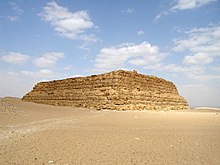
Mastabas are burying tombs that hold royal significance. Every bit chosen by Egyptian rulers, many of the tombs establish throughout time were located along the Nile river.[24] The structural outside regarding Mastabas varies throughout history just in that location is a noticeable evolution of the course of Egyptian dynasties. The mastabas of the Start Egyptian Dynasty would be created through the utilize of stepped bricks.[25] The design would then evolve past the fourth dimension of the 4th Dynasty equally the structural exterior modify from brick to rock.[25] The reasoning behind the stepped designs of mastabas is continued to the idea of "accretion".[25] Lateral penetration was a concern in when constructing tombs. In order to preclude damage to the structure, brickwork layers were placed around the base of structure.[25] Mastabas from the old empire, took upon a pyramid pattern structure.[24] This design was largely reserved for rulers, such equally the king, and his family unit equally a means for burying.[24] Other blueprint characteristics regarding mastabas from the sometime empire include having rectangular outlines, walls that were slanted, which were made of stone and brick materials, and having the axis of a building run both North and South.[24] Multiple elements brand up the interior of mastabas such as an offer chamber, statues for the dead, and a vault beneath which held sarcophagi.[24] Past the stop of the former Empire, the usage of these tombs were abandoned.
Gardens [edit]
Three types of gardens are attested from aboriginal Egypt: temple gardens, individual gardens, and vegetable gardens. Some temples, such equally those at Deir el-Bahri, were provided with groves and trees, especially the sacred Ished Tree (Persea). Individual pleasance gardens are known from an 11th Dynasty tomb model of Meketra, and from tomb decoration of the New Kingdom. They were typically surrounded by a high wall, planted with trees and flowers, and provided with shady areas. Plants were cultivated for fruits and fragrance. Flowers included cornflowers,[26] poppies and daisies, while the pomegranate, introduced in the New Kingdom, became a pop shrub. The gardens of wealthier individuals were bundled effectually an ornamental pool for fish, waterfowl and h2o-lilies. Vegetable plots, whether privately owned or belonging to temples, were laid out in squares divided by water channels, and located shut to the Nile. They were irrigated past manus, or (from the late 18th Dynasty) past ways of the shaduf.
-
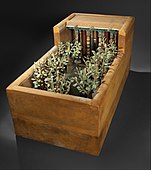
Model of Meketra'south business firm and garden from his tomb at Thebes, which consists of a shady grove of trees surrounding a central garden; circa 1981–1975 BC; painted wood and copper; height: 39.five cm (fifteen 9⁄16 in.); Metropolitan Museum of Fine art (New York City)
-
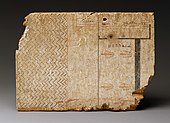
Architectural drawing of a garden, on a writing board; circa 1550–1295 BC; plastered and painted wood; height: 23.v cm (9 i⁄4 in.); Metropolitan Museum of Art
-

Brickmakers getting water from a pool; circa 1479–1425 BC; tempera on paper; from the tomb of Rekhmire; Metropolitan Museum of Art
Meet also [edit]
- Art of ancient Egypt
- Center for Documentation of Cultural and Natural Heritage
- Edfu
- Egyptian pyramid construction techniques
- Egyptian Revival architecture
- Egyptian revival decorative arts
- Listing of ancient Egyptian sites
- Medinet Habu
- Urban planning in aboriginal Egypt
- Coptic compages
Notes and references [edit]
- ^ R. G. Blakemore, History of Interior Blueprint and Furniture: From Ancient Egypt to Nineteenth-Century Europe, John Wiley and Sons 1996, p.100
- ^ Blakemore, 1996, p.107
- ^ W. Yard. Flinders Petrie, Kahun, Gurob, and Hawara, Kegan Paul, Trench, Trübner, and Co., London 1890
- ^ Charles Gates, Ancient Cities: The Archeology of Urban Life in the Ancient Almost E and Egypt, Greece and Rome, Routledge 2003, p.101
- ^ Dieter Arnold, Byron Esely Shafer Temples of Aboriginal Egypt, I.B.Tauris, 2005
- ^ Blakemore, 1996, pp.107ff.
- ^ Arnold, 2005, pp.204ff
- ^ "Temples aligned with the stars", New Scientist 2724 (5 Sep. 2009), p. 7; encounter also J. Belmonte & 1000. Shaltout, "Keeping Ma'at: an astronomical approach to the orientation of the temples in ancient Egypt", Advances in Space Research (Baronial 2009) doi:10.1016/j.asr.2009.03.033
- ^ Winston, Alan. "An overview of the Giza Plateau in Egypt". Retrieved 26 July 2011.
- ^ a b c d eastward Reich, Lawrence S. Cunningham, John J. (2010). Culture and values : a survey of the humanities (seventh ed.). Boston, MA: Wadsworth Cengage Learning. ISBN978-0-495-56877-3.
- ^ "The 7 Wonders of the Ancient World". Archived from the original on 8 Baronial 2011. Retrieved 26 July 2011.
- ^ a b Lehner, Mark. "The Pyramid of Khafre". The Consummate Pyramids. Archived from the original on 28 July 2011. Retrieved 26 July 2011.
- ^ "Pyramid of Mankaure". National Geographic: Egypt. National Geographic Society. Archived from the original on 2 October 2011. Retrieved 26 July 2011.
- ^ Gulio, Magli (2013). Architecture, Astronomy and Sacred Landscape in Aboriginal Egypt. Cambridge Academy Press.
- ^ Wilkinson, R. (2000). The Complete Temples of Ancient Egypt . New York, Thames & Hudson. pp. 154.
- ^ Dieter, Arnold (2003). The encyclopaedia of ancient Egyptian architecture . I.B. Tauris. pp. 196. ISBNane-86064-465-1.
- ^ a b c d e f grand h i j k Koltsida, Aikaterini (2007). "A Dark Spot in Ancient Egyptian Architecture: The Temple of Malkata". Journal of the American Research Center in Arab republic of egypt. 43: 43–57 – via Jstor.
- ^ a b "Reconstruction of Geometric Decoration". Metropolitan Museum of Fine art.
- ^ Lansing, Ambrose (1918). "Excavations at the Palace of Amenhotep III at Thebes". The Metropolitan Museum of Fine art Message. 13 (three): 8–14. doi:10.2307/3254041. JSTOR 3254041.
- ^ a b c d east Lawrence, A. (1965). Aboriginal Egyptian Fortifications. The Journal of Egyptian Archaeology,51(ane), 69-94.
- ^ a b c Clarke, S. (1916). Aboriginal EGYPTIAN FRONTIER FORTRESSES. Journal of Egyptian Archaeology, 3, 155.
- ^ a b c d e f chiliad h i j Stanley, Jean-Daniel, et al. "Pelusium, an Ancient Port Fortress on Egypt'southward Nile Delta Coast: Its Evolving Ecology Setting from Foundation to Demise." Periodical of Coastal Inquiry, vol. 24, no. 2, 2008, pp. 451–462. JSTOR, JSTOR, world wide web.jstor.org/stable/30137849.
- ^ a b c d e Aaron A. Burke, et al. "Excavations of the New Kingdom Fortress in Jaffa, 2011–2014: Traces of Resistance to Egyptian Dominion in Canaan." American Periodical of Archaeology, vol. 121, no. 1, 2017, pp. 85–133. JSTOR, JSTOR, www.jstor.org/stable/10.3764/aja.121.one.0085.
- ^ a b c d due east L. E. R. "Two Mastaba Chambers." Museum of Fine Arts Bulletin, vol. viii, no. 45, 1910, pp. 19–20. JSTOR, JSTOR, www.jstor.org/stable/4423469.
- ^ a b c d Badawy, Alexander. "The Credo of the Superstructure of the Mastaba-Tomb in Egypt." Journal of Near Eastern Studies, vol. fifteen, no. three, 1956, pp. 180–183. JSTOR, JSTOR, world wide web.jstor.org/stable/542310.
- ^ https://www.liverpoolmuseums.org.uk/stories/gardens-ancient-arab republic of egypt[ bare URL ]
Further reading [edit]
- Arnold, Dieter. The encyclopedia of ancient Egyptian architecture. Cairo: American University in Cairo Printing, 2003.
- Fletcher, Banister; Cruickshank, Dan, Sir Banister Fletcher's a History of Architecture, Architectural Press, 20th edition, 1996 (outset published 1896). ISBN 0-7506-2267-9. Cf. Part One, Affiliate iii.
- Hill, Marsha (2007). Gifts for the gods: images from Egyptian temples. New York: The Metropolitan Museum of Art. ISBN9781588392312.
External links [edit]
- AEgArOn - Aboriginal Egyptian Architecture Online, open source project
Source: https://en.wikipedia.org/wiki/Ancient_Egyptian_architecture



0 Response to "What engineering feat was this pharaohs gift to the people of Egypt"
Post a Comment